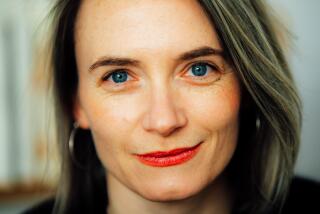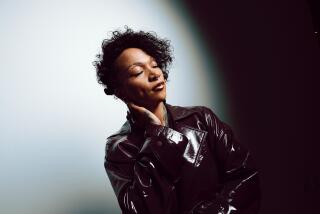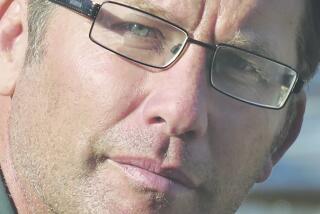Warm memories of her Arctic years
Parents who travel with children often say that in some of the most exotic, faraway places they are befriended, even welcomed, into peopleâs homes because they have their little ones in tow.
In the early â70s, 10-month-old Kari Herbert served as just such an icebreaker for her mother and father in an Inuit hunting village on a remote, icebound islet off the northwest coast of Greenland, 860 miles south of the North Pole.
Kariâs father is British explorer Wally Herbert, who completed the first crossing of the Arctic Ocean by foot and dog sled, by way of the North Pole, in 1969. Two years later, he took his wife, Marie, and daughter Kari to the Thule (pronounced âToolieâ) region of Greenland to document the vanishing lifestyle of the Inuit people who had helped train him for his expedition.
The Inuits are master hunters and dog sledders and are thought to have migrated from northern Canada to Thule around 1000. But in the two years they stayed there, the Herberts watched as the traditions that had sustained the Inuit in the most unforgiving conditions began to yield to encroaching modernization, with mostly unhappy results.
In âThe Snow People,â published in 1973, Marie Herbert described what she saw as âthe closing scenes of a dying culture.â
Now the toddler who beguiled her Inuit neighbors, living on the ice in a tiny hut and eating whale blubber, is 34, a photographer and the author of âThe Explorerâs Daughter,â published last fall in Britain. It tells the story of her return to Thule in 2002 to rekindle old friendships.
I recently spoke by phone with Kari, who lives in a leafy, green suburb of London, totally unlike the High Arctic.
*
Question: Did you open doors for your parents in Thule?
Answer: Mom and Dad say it was much easier for them to enter the community because of me. The Inuit go completely potty over kids, and I had curly blond hair. Some of them cut off locks of it to keep as amulets.
I think my mom didnât quite realize what she was getting into when we left England. On the ship, she had major second thoughts, but it was too late to turn back. She is a person with an adventurous spirit that awoke when she met my dad. She saw he was extraordinary and wanted to be a part of it.
*
Q: What exactly does blubber taste like?
A: It has a very delicate flavor, a little like avocado, and a strange texture, crunchy and hard to chew.
When I was a child, I even liked kiviak, a delicacy in Thule. They caught little birds called auks, then put them in a sealskin bag under a cairn of rocks. Three to six months later, they opened it up. It stank to high heaven and looked like a gooey mess. When I went back as an adult, I found it very difficult [to eat], but as a child it seemed completely normal.
Everything did, even the lack of privacy. You were never alone, even for simple things like going to the toilet. You had to go out onto the ice and deal with it. Now they have indoor toilets.
But they still donât have fruit and vegetables. They used to get all their vitamins and minerals from blubber, but now they donât hunt as much as they used to. They watch TV and eat packaged foods. And they have to eat a lot to generate heat. So they struggle with diabetes, heart disease and obesity.
*
Q: You could have just held onto your childhood memories, but you went back. Why?
A: In 1994, my mom and dad were lecturing on an Arctic cruise ship and asked me to go along. We were in Thule for only 24 hours, but it was a time of heightened emotion, seeing old friends and how much of the culture had been lost while weâd been away. I knew then Iâd have to go back to find out what my connection to the place meant. My earliest childhood memories were of being welcomed into a tribal community. It was such a powerful experience. I couldnât ignore it.
*
Q: I was shocked and saddened to read in your book about the changes that have come to the Greenland Inuit in the last 20 years -- the abandonment of the island settlement where you lived as a child when the government closed the village store in 1979, the waning of hunting, unemployment and dependence on the government dole, crime, suicide, rampant alcoholism, child abuse. Were you prepared for all this when you went back?
A: I had no idea alcoholism had gotten so bad. There was a spate of drunken wives killing their husbands from about 1975 to 1980 and young people committing suicide in the late â90s.
Traditionally, the Inuit consumed every part of the animals they hunted, so there was no rubbish. But now itâs piling up -- especially the plastic....
Then, too, there are political issues -- not so much with Denmark [which rules Greenland] as with the U.S., because of its seizure of ancestral Inuit land when the air base at Uummannaq was built during the Cold War [by agreement with the Danes]. The people heard so much about terrorism and thought the antiballistic missile early-warning system would make them a target.
*
Q: Are the Greenland Inuit headed for extinction?
A: Elements of the culture are dying. Life will never be what it was. But some people will try harder to keep traditions alive.
*
Q: How did living in that culture shape you?
A: The experience of being accepted in a tribal community had a tremendous impact. It was such a nurturing and loving place to be. When I went back to England, I found it difficult to adjust. I didnât understand why I couldnât go up to people and give them a hug .... I didnât want to talk about my experiences in Greenland for a long time.
But now, I want to have kids. And when I do, I wouldnât hesitate to take them there.
*
Susan Spano also writes âPostcards From Paris,â which can be read at latimes.com/susanspano.
More to Read
Sign up for The Wild
Weâll help you find the best places to hike, bike and run, as well as the perfect silent spots for meditation and yoga.
You may occasionally receive promotional content from the Los Angeles Times.






